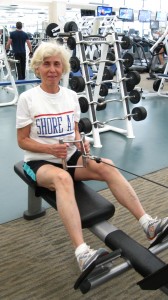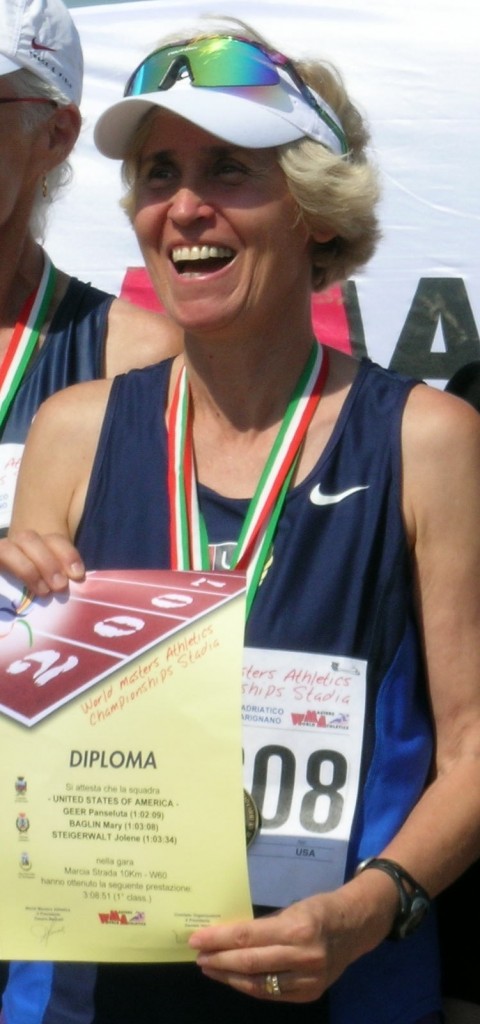by Michelle Sutton-Kerchner
Want to add to your competitive events calendar? Need new motivation for your fitness routine? It’s time for race walking …
When we think of a good walk, we typically don’t think of a sporting event. We imagine someone traversing the neighborhood at random, getting exercise and fresh air. We might picture a power walker, with mini weights in hand, pumping arms and listening to an iPod. Race walking redefines these notions. Prepare for a new concept: the athletic walker.
From Whence?
Dating back to the 1880s, race walking is not a new sport. It was born from pedestrianism– long-distance competitive walking events, popular along with horse and foot racing, as a spectator sport and opportunity to wager. In good company, race walking joined European football (soccer), cricket, and other sports that became regularized during this period of history when the rules were codified.
Shortly after, race walking was added to the Olympics roster. Today, it’s included in events at the International Association of Athletics Federations (IAAF) World Championships, the Commonwealth Games, and the Pan American Games. A World Cup race walk is held biennially.
How-To: Race Walking for Dummies
Many race walkers are retired runners who got injured. As any runner admits, running adds wear-and-tear to the body. Injuries, particularly stress injuries, sometimes occur. Race walking seems a logical solution. To others, race walking provides more opportunities to thrill the competitive streak within. Warning to this group: Conversion from running to race walking can be tricky.
Challenging in its own right, most runners have their own gait and go for speed and endurance. Race walking is defined by technicalities, meticulous details that assure it’s a walk and not a run. During events, the judging is critical. The smallest discrepancy is cause for disqualification or dispute.
Experts advise wannabes to spend time first learning correct stride. Each person’s technique differs, based on factors like body proportion, size, and strength. What might allow one race walker to meet official criteria could cause another an injury. Those new to exercise might have an easier time with race walking than the experienced runner. They don’t have a style to unlearn or preconceived ideas to dismiss.
Begin with a slow pace and focus on skill development. Once accomplished, increasing speed comes easily and safely. Some runners abandon running once they discover they can more efficiently progress in race walking without interference from injuries typical in running.
Race walk requirements insist the advancing leg be straight (not bent at the knee) when the heel hits the ground, and stay straight as the body moves over the planted foot. Also, at least one foot must appear to be in contact with the ground at all times. According to slow-motion captured images, race walkers may show a flight phase (both feet off the ground). However, it should be short enough to remain undetected by the human eye. Otherwise, the walker is penalized for “lifting.” Legal race walking, as established by the USA Track & Field (USATF) organization, is characterized by these main rules.
Training for the Race Walk

As when training for any competitive event, it’s important to include drills of that event in your fitness routine. With race walking, it’s essential to practice the techniques mastered in the learning phase and execute them in mock race walks. These drills allow you to gauge speed and endurance level. Cross training helps you improve on them.
When choosing cross training methods, focus on making weak areas stronger. To improve endurance, engage in cardio-enhancing exercises. Group Fitness classes are often aerobic in nature and deliver an intense cardio routine. Aquatic classes or regular swim sessions also improve endurance. Attack your training program from a new angle. Muscles overworked from race walking earn a rest and injured areas get a chance to heal.
Member Panse Geer, voted the USATF 2007 Female Masters Race Walker of the Year, attributes much of her success in the race-walking world to her training at the Center. “Race walking takes skill, good conditioning, and a lot of practice. Working out at the Center is an important aspect of my conditioning.” Panse focuses on strengthening her upper body, which allows her to maintain the strict form required in race walking.
Veterans in the race walking world encouraged Panse to join the Center. Here, her personal trainer created a fitness program specifically focused on improving skills needed in the sport. Panse also takes advantage of the equipment variety on the Exercise Floor, complementing her routine with occasional Pilates and yoga classes. Her goal is to continuously improve endurance and core strength to enjoy her best performance in the next race.
Studies show race times quickly improve when adding strength conditioning to a workout. Focus on increasing strength without adding weight or bulk. Consider executing more reps with lighter weights to accomplish this. Long, lean muscles are the goal. Pilates is also a good method of strength training that avoids bulk.
Speak with a personal trainer for some warm-up exercises. These should be performed prior to stretching to avoid pulling cold, tight muscles. Discover favorites and change them regularly. Always work on your stronger side last. By nature, more effort and time is expended during the first round of stretching or strengthening. Put the initial enthusiasm to work on your weaker side to help dispel discrepancies and minimize overcompensation injuries.
Panse’s Accomplishments

A hard woman to catch, Panse’s most recent achievement is owner of the 20,000-meter race walk record for women age 64. When Panse began race walking nine years ago, her times were about 12 minutes per mile. After vigorous training and dedication, her times dropped to about nine minutes per mile. This improvement earned her top-level status for race walkers her age in the United States.
Propelled to expand her opportunities, Panse began to participate in national and international competitions, including such far-flung event locations as Italy with Finland on her agenda. Her race times reflect a competitive edge. “Keeping in shape pays off, in athletics as well as life,” comments Panse. Yet another reasons to exercise– it could be your ticket to exotic locales.
Panse reflects on her inspiration to begin race walking . “My husband and I were members of the Shore Athletic Club. Several members were active race walkers, including some former Olympians, who encouraged runners to try the sport. Once I discovered my passion for it, I intensified training and found success.”
You’re starting to rethink those walkers now, aren’t you? We aren’t talking about your average mall walker here, with all due respect to them. Surely, it takes skill to whiz by sale after sale in tempting window displays. The only whiz in race walking is the sound of air as you speed past your last record.
Sources
Image Credits
Race walking (introductory photo): http://www.flickr.com/photos/peterm7/5843349569
 Fitness & Wellness News Your Source for Fitness News, Wellness News, Health News, and Nutrition News!
Fitness & Wellness News Your Source for Fitness News, Wellness News, Health News, and Nutrition News!



